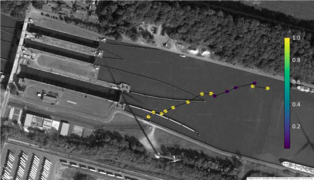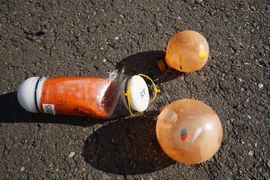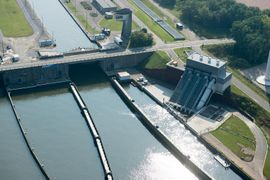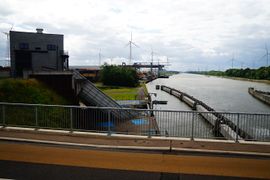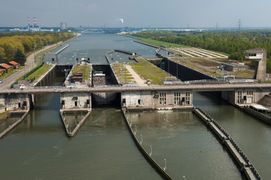Difference between revisions of "Ham test case"
Bendikhansen (talk | contribs) |
Bendikhansen (talk | contribs) |
||
| (17 intermediate revisions by 2 users not shown) | |||
| Line 1: | Line 1: | ||
[[Category:Test cases]] | [[Category:Test cases]] | ||
| − | { | + | {{Fact box for Ham}} |
| − | |||
| − | |||
| − | |||
| − | |||
| − | |||
| − | |||
| − | |||
| − | |||
| − | |||
| − | |||
| − | |||
| − | |||
| − | |||
| − | |||
| − | |||
| − | |||
| − | |||
| − | |||
| − | |||
| − | |||
| − | |||
| − | |||
| − | |||
| − | |||
{{Relevant SMTDs for Ham}} | {{Relevant SMTDs for Ham}} | ||
| Line 32: | Line 8: | ||
The ship lock complex of Ham is situated at 77,2 km of the river Meuse. The canal and its side-canals are almost entirely fed by water of the river Meuse, and are directly connected to it in the city of Liège. The water in the Albert canal is used for shipping, industry, drinking water supply, irrigation, and cooling of the nuclear power plant of Antwerp. The discharge of the Canal is regulated and depends on the discharge of the river Meuse. | The ship lock complex of Ham is situated at 77,2 km of the river Meuse. The canal and its side-canals are almost entirely fed by water of the river Meuse, and are directly connected to it in the city of Liège. The water in the Albert canal is used for shipping, industry, drinking water supply, irrigation, and cooling of the nuclear power plant of Antwerp. The discharge of the Canal is regulated and depends on the discharge of the river Meuse. | ||
| − | The river Meuse is a typical rain fed river that stretches from France through Belgium ending up in an embanked estuary in The Netherlands with a total fall of 409m. This 935km long river has a discharge area of 36. | + | The river Meuse is a typical rain fed river that stretches from France through Belgium ending up in an embanked estuary in The Netherlands with a total fall of 409m. This 935km long river has a discharge area of 36.000km<sup>2</sup> and its mean discharge is 230m<sup>3</sup>, peaking up to tenfold after long and heavy rainfall. The hydrology of the Albert canal is entirely artificial and controlled by humans for shipping and other purposes. The water level in each canal section depends on the water supply from the Meuse river, besides rainfall and the shipping/ship lock activity, the withdrawal of water for irrigation, drinking or cooling water, and the use of water for electricity production by the Archimedes screws in the pumping/hydropower station(s). |
=About the hydropower plant= | =About the hydropower plant= | ||
The ship lock complex of Ham, as well as the ones of Olen and Hasselt, is by-passed by a small channel that runs through the hydropower station. The hydropower station contains the largest Archimedes screw in the world, which cannot only pump, but also turbinate water (two operational modes for one and the same screw). | The ship lock complex of Ham, as well as the ones of Olen and Hasselt, is by-passed by a small channel that runs through the hydropower station. The hydropower station contains the largest Archimedes screw in the world, which cannot only pump, but also turbinate water (two operational modes for one and the same screw). | ||
| − | The hydropower station in Ham has one closed Archimedes screw. This screw has its housing attached to the blades, preventing fish from being squeezed between the blades and the housing | + | The hydropower station in Ham has one closed Archimedes screw. This screw has its housing attached to the blades, preventing fish from being squeezed between the blades and the housing. It has a length of 22 m, a diameter of 4.3 m, an inclination angle of 38° and a weight of 85 tons. The highly efficient Archimedean screw is able to generate electricity 24 hours a day, whilst maintaining the natural flow of a river. It has an installed capacity of 1.2 MW |
===Layout=== | ===Layout=== | ||
The area around the HPP is highly artificial. The hydropower station, which also serves as pumping station, is located in a by-pass channel ( 380 x 6 meters) bridging the ship lock complex of Ham. This by-pass channel is a concrete channel. Fish can freely swim from the Albert canal to the by-pass channel. The Albert canal itself is a large concrete shipping canal. It is 130 km long and runs nearly straight from the river Meuse in the East of Belgium to the river Scheldt in the West. The height difference between the rivers Meuse and Scheldt is bridged by 6 shipping lock complexes. Each ship lock complex has two ship locks of 136 by 16 m and one push-convoy lock of 200 by 24 m. The banks of the canal over its 130 km length are concrete and straight and thus not even semi-natural. | The area around the HPP is highly artificial. The hydropower station, which also serves as pumping station, is located in a by-pass channel ( 380 x 6 meters) bridging the ship lock complex of Ham. This by-pass channel is a concrete channel. Fish can freely swim from the Albert canal to the by-pass channel. The Albert canal itself is a large concrete shipping canal. It is 130 km long and runs nearly straight from the river Meuse in the East of Belgium to the river Scheldt in the West. The height difference between the rivers Meuse and Scheldt is bridged by 6 shipping lock complexes. Each ship lock complex has two ship locks of 136 by 16 m and one push-convoy lock of 200 by 24 m. The banks of the canal over its 130 km length are concrete and straight and thus not even semi-natural. | ||
| Line 72: | Line 48: | ||
* Acoustic telemetry study on downstream migration pathways of european eel and salmon smolts | * Acoustic telemetry study on downstream migration pathways of european eel and salmon smolts | ||
=Results= | =Results= | ||
| + | In this study the impact on fish of worlds’ largest Archimedes screws (10 m head, 22 m length) was assessed. The screws are installed in a pumping and hydropower installation that is situated in a side channel of the shipping lock complex of Kwaadmechelen (Ham, Belgium) on the Albert canal. On the one hand, the percentage of downstream migrating eels and salmons that passed the sluice complex via the hydropower installation was assessed by one- and two-dimensional tracking with acoustic telemetry. On the other hand, the direct impact of the screws on passing bream, eel and roach was evaluated by forced passage of fish and barotrauma sensors. | ||
| + | |||
| + | The telemetric study indicated that 65% of 86 tracked eels that reached the sluice complex during downstream migration tried to pass the sluice complex. 14 % of those (14% of 56 eels or 9% of 86 eels) finally passed the sluice complex via the by-pass channel and hydropower installation. In contrast, none of the 44 smolts (out of 72 smolts tracked) that tried to pass the sluice complex entered the by-pass channel and passed the hydropower installation. Figure 1 shows the swim track of one of the eels that passed the sluice complex via the hydropower installation. | ||
| + | |||
| + | The life fish experiments with forced passage indicated a chance to die or get severely injured of up to 55% (range 43-64%), 17% (range 11-24%) and 34% (range 30-36%) for bream, eel and roach, respectively. Most severely injured fish were observed to have a contusion (Figure 2). Accordingly, crushing and grinding were the main source of damage to the BDSs as could be observed at the surface of the BDS units (Figure 3). The BDS sensor values subscribe the results of previous studies, which show that barotrauma or pressure related injuries remain unlikely at Archimedes screw turbines. Interestingly, the sensors and accompanying statistical tests indicated that not two of all sensor passage events performed, were similar. So, the passage of sensors was a chaotic event. Consequently, the operational discharge had no effect on the sensor data, neither on the observed crushes (and scratches) of (on) the sensors. Small effects of this were found on the tested fish, however the effect was not found for every tested species and was not similar for those where an effect was found for. We therefore conclude that operational discharge is not influencing the harmfulness of the screws to passing fish and we do not recommend it as a mitigation measure. Interestingly, the next question rising from the observations made in this study is how the uniqueness of the data is related to the observations on life fish. Anyway, the injuries that were observed the most were scale loss for less than 25% of the fish body and contusions. The observation of contusions on fish and crushes of sensors indicate that fish and sensors were squeezed between the blades and the screw housing. However, it was not possible to investigate where this happens and if it exclusively happens in the beginning at the first blade upon screw entrance. Further research could be dedicated to finding the exact origin of these types of severe injuries to further adapt screw design and improve fish friendliness. | ||
| + | |||
| + | <gallery mode=packed> | ||
| + | eel_track.png|Figure 1: 2-D track of a downstream migrating tagged eel passing the sluice complex via the side-channel and hydropower installation (HPP not in the picture). Colours indicate the precision of each detected and calculated fish position (dots) on a scale of 1 (minimally 5 m precise) to 0 (maximally 5 m precise). | ||
| + | eel_injury.png|Figure 2: External (a) and internal (b) impact of a contusion of an eel that died and got injured during Archimedes screw passage in Kwaadmechelen (Ham, Belgium). | ||
| + | crushed_bds_tube.jpg|Figure 3: Crushed BDS sensor tube after Archimedes screw passage in Kwaadmechelen (Ham, Belgium). | ||
| + | </gallery> | ||
| + | |||
| + | =Gallery= | ||
| + | <gallery mode=packed> | ||
| + | Ham1_Arial_picture_HPP_cDe-Vlaamse-Waterweg.jpg|Areal photograph of the Ham complex. | ||
| + | Ham2_cDe-Vlaamse-Waterweg.jpg|View of the Albert canal downstream of the Ham complex, as seen from the dam. | ||
| + | ham<sup>3</sup>_cDe-Vlaamse-Waterweg.jpg|Archimedes screw turbines at the Ham complex. The three on the left are reversible, while the closed screw on the right is for pumping and upstream fish passage only. | ||
| + | ham4_Ship_lock_complex_cDe-Vlaamse-Waterweg.jpg|Ship lock complex at Ham. | ||
| + | </gallery> | ||
| + | |||
| + | =References= | ||
| + | * Baeyens R, Pauwels I, Buysse D, Mouton A, Vergeynst J, Papadopoulos I, Demaerteleire N, Pieters S, Gelaude E, Robberechts K, Verhelst P, Vermeersch S, Vandamme L, Coeck J (2019) Monitoring van de effecten van de pompinstallatie en waterkrachtcentrale te Ham op het visbestand in het Albertkanaal. Reports from the Research Institute for Nature and Forest Brussels, Belgium https://doi.org/10.21436/inbor.15830647. | ||
| + | |||
| + | * Vergeynst J (2020) Downstream eel and salmon migration through a shipping canal : challenges on the road . Ghent University (UGhent) and Research Institute for Nature and Forets (INBO). | ||
Latest revision as of 11:06, 18 June 2020
| Fact box: Ham | |
|---|---|
| Country | Belgium |
| River | Albert canal |
| Operator | De Vlaamse Waterweg |
| Capacity | 1.2 MW |
| Head | 10 m |
| Inter-annual discharge | |
| Turbine(s) | 1 Archimedes screw turbine |
| Detailed report | Click for pdf |
Contents
Introduction
The shipping lock complex and accompanying HPP studied here is located in the Albert canal in the municipality of Ham (Kwaadmechelen, Belgium). The Albert canal is one of the most important shipping routes of Flanders as it connects the River Scheldt via the Port of Antwerp, with the River Meuse and the Juliana Canal. It was dug in the 1930’s.
The ship lock complex of Ham is situated at 77,2 km of the river Meuse. The canal and its side-canals are almost entirely fed by water of the river Meuse, and are directly connected to it in the city of Liège. The water in the Albert canal is used for shipping, industry, drinking water supply, irrigation, and cooling of the nuclear power plant of Antwerp. The discharge of the Canal is regulated and depends on the discharge of the river Meuse.
The river Meuse is a typical rain fed river that stretches from France through Belgium ending up in an embanked estuary in The Netherlands with a total fall of 409m. This 935km long river has a discharge area of 36.000km2 and its mean discharge is 230m3, peaking up to tenfold after long and heavy rainfall. The hydrology of the Albert canal is entirely artificial and controlled by humans for shipping and other purposes. The water level in each canal section depends on the water supply from the Meuse river, besides rainfall and the shipping/ship lock activity, the withdrawal of water for irrigation, drinking or cooling water, and the use of water for electricity production by the Archimedes screws in the pumping/hydropower station(s).
About the hydropower plant
The ship lock complex of Ham, as well as the ones of Olen and Hasselt, is by-passed by a small channel that runs through the hydropower station. The hydropower station contains the largest Archimedes screw in the world, which cannot only pump, but also turbinate water (two operational modes for one and the same screw).
The hydropower station in Ham has one closed Archimedes screw. This screw has its housing attached to the blades, preventing fish from being squeezed between the blades and the housing. It has a length of 22 m, a diameter of 4.3 m, an inclination angle of 38° and a weight of 85 tons. The highly efficient Archimedean screw is able to generate electricity 24 hours a day, whilst maintaining the natural flow of a river. It has an installed capacity of 1.2 MW
Layout
The area around the HPP is highly artificial. The hydropower station, which also serves as pumping station, is located in a by-pass channel ( 380 x 6 meters) bridging the ship lock complex of Ham. This by-pass channel is a concrete channel. Fish can freely swim from the Albert canal to the by-pass channel. The Albert canal itself is a large concrete shipping canal. It is 130 km long and runs nearly straight from the river Meuse in the East of Belgium to the river Scheldt in the West. The height difference between the rivers Meuse and Scheldt is bridged by 6 shipping lock complexes. Each ship lock complex has two ship locks of 136 by 16 m and one push-convoy lock of 200 by 24 m. The banks of the canal over its 130 km length are concrete and straight and thus not even semi-natural.
The Operator: De Vlaamse Waterweg
The “Vlaamse Waterweg NV” is an agency of the Flemish government. It manages and operates the waterways as a powerful network that contributes to the economy, prosperity and liveability of Flanders. The “Vlaamse Waterweg NV” strengthens transport via inland shipping, ensures water management and increases the attractiveness of the waterways for recreation, tourism and nature experience. Read more.
Pressures on the water body's ecosystem
Polution: The water quality of the Albert canal is rather good, although lots of industry is situated in the area of the canal. The surface water is also used for drinking water supply. Nevertheless, the biological live is moderate due to the highly artificial morphology of the river. This is reflected in the Index of Biotic Integrity (IBI), which indicates that the state of the fish populations in the Albert canal is only moderate to poor.
Morphology: The HPP is situated in a by-pass channel of a large shipping canal. Hence, both the morphology as well as the hydrology in this area is highly artificial. The banks are vertical and made of concrete and water vegetation is absent. The water level and flow are regulated by the shipping lock complexes and accompanying pumping/hydropower stations. The net flow is directed from the Meuse River to the Scheldt river. However, the instant flow can be directed either towards the Scheldt river or the Meuse river, depending on the emptying and filling of the shipping lock complexes upstream and downstream of each of eight canal section.
Migration delay: Notwithstanding the highly artificial nature of this aquatic system, diadromous fish species use the shipping canal as a migration route to and from the North Sea. While fishmigration is happening, it is heavliy delayed du to the presence of several ship lock complexes on the canal.
Test case topics
Fish population
As indicated by the Index of Biotic Integrity (IBI), the fish community in the Albert canal has a poor to moderate state. Catch efforts in the canal for the European Water Framework Directive between 2014 and 2018, indicate the occurrence of 20 fish species of which roach (Rutilus rutilus) is the far most dominant species. Unfortunately the fish community in the canal suffers a lot from exotic species, such as the round goby, which is the third most dominant fish species already. The fish populations even suffer from the dominant occurrence of the exotic, red swamp crayfish (Proterorhinus semilunaris).
Fish migration
There is no migration device. The potential routes for a fish to migrate are:
- Migrate upstream trough a ship lock by swimming though the downstream and upstream open gates
- Migrate upstream by passing the Archimedes screws of the hydropower plant in pumping mode
- Migrate downstream through a ship lock by swimming passed an open gate
- Migrate downstream through a ship lock by passing through the filling system
- Migrate downstream from the ship lock to the canal through either an open gate, or the emptying system of the ship lock
- Migrating downstream through the by-pass channel leading to the hydropower plant and passing through the Archimedes screws in turbine mode.
Research objectives and tasks
At the shipping canal and ship lock complex of the Test Case Ham, the impact of Archimedes screw hydropower plant on the local fish population is investigated. Specifically: The impact of the hydropower station (3 open Archimedes screws as turbines) on fish that pass the screws is studied by evaluating the mortality and injury of fish that passed the screws in turbine mode. The impact of the hydropower station on fish is evaluated through several pressure-related parameters by barotrauma sensor tests that pass the screws. The impact of the hydropower plant on the local fish population and downstream migrating eel and salmon is investigated by evaluation of the (relative) number of fish that pass the sluice complex in the downstream direction by the by-pass channel and hydropower station (instead of taking the ‘route’ of the ship locks in the canal).
Research tasks
The research tasks and field studies conducted at Ham are:
- Life fish experiments for turbine induced damage
- Testing of barotrauma stress caused by turbine passage with sensors (Barotrauma Detection System)
- Acoustic telemetry study on downstream migration pathways of european eel and salmon smolts
Results
In this study the impact on fish of worlds’ largest Archimedes screws (10 m head, 22 m length) was assessed. The screws are installed in a pumping and hydropower installation that is situated in a side channel of the shipping lock complex of Kwaadmechelen (Ham, Belgium) on the Albert canal. On the one hand, the percentage of downstream migrating eels and salmons that passed the sluice complex via the hydropower installation was assessed by one- and two-dimensional tracking with acoustic telemetry. On the other hand, the direct impact of the screws on passing bream, eel and roach was evaluated by forced passage of fish and barotrauma sensors.
The telemetric study indicated that 65% of 86 tracked eels that reached the sluice complex during downstream migration tried to pass the sluice complex. 14 % of those (14% of 56 eels or 9% of 86 eels) finally passed the sluice complex via the by-pass channel and hydropower installation. In contrast, none of the 44 smolts (out of 72 smolts tracked) that tried to pass the sluice complex entered the by-pass channel and passed the hydropower installation. Figure 1 shows the swim track of one of the eels that passed the sluice complex via the hydropower installation.
The life fish experiments with forced passage indicated a chance to die or get severely injured of up to 55% (range 43-64%), 17% (range 11-24%) and 34% (range 30-36%) for bream, eel and roach, respectively. Most severely injured fish were observed to have a contusion (Figure 2). Accordingly, crushing and grinding were the main source of damage to the BDSs as could be observed at the surface of the BDS units (Figure 3). The BDS sensor values subscribe the results of previous studies, which show that barotrauma or pressure related injuries remain unlikely at Archimedes screw turbines. Interestingly, the sensors and accompanying statistical tests indicated that not two of all sensor passage events performed, were similar. So, the passage of sensors was a chaotic event. Consequently, the operational discharge had no effect on the sensor data, neither on the observed crushes (and scratches) of (on) the sensors. Small effects of this were found on the tested fish, however the effect was not found for every tested species and was not similar for those where an effect was found for. We therefore conclude that operational discharge is not influencing the harmfulness of the screws to passing fish and we do not recommend it as a mitigation measure. Interestingly, the next question rising from the observations made in this study is how the uniqueness of the data is related to the observations on life fish. Anyway, the injuries that were observed the most were scale loss for less than 25% of the fish body and contusions. The observation of contusions on fish and crushes of sensors indicate that fish and sensors were squeezed between the blades and the screw housing. However, it was not possible to investigate where this happens and if it exclusively happens in the beginning at the first blade upon screw entrance. Further research could be dedicated to finding the exact origin of these types of severe injuries to further adapt screw design and improve fish friendliness.
Figure 1: 2-D track of a downstream migrating tagged eel passing the sluice complex via the side-channel and hydropower installation (HPP not in the picture). Colours indicate the precision of each detected and calculated fish position (dots) on a scale of 1 (minimally 5 m precise) to 0 (maximally 5 m precise).
Gallery
References
- Baeyens R, Pauwels I, Buysse D, Mouton A, Vergeynst J, Papadopoulos I, Demaerteleire N, Pieters S, Gelaude E, Robberechts K, Verhelst P, Vermeersch S, Vandamme L, Coeck J (2019) Monitoring van de effecten van de pompinstallatie en waterkrachtcentrale te Ham op het visbestand in het Albertkanaal. Reports from the Research Institute for Nature and Forest Brussels, Belgium https://doi.org/10.21436/inbor.15830647.
- Vergeynst J (2020) Downstream eel and salmon migration through a shipping canal : challenges on the road . Ghent University (UGhent) and Research Institute for Nature and Forets (INBO).
